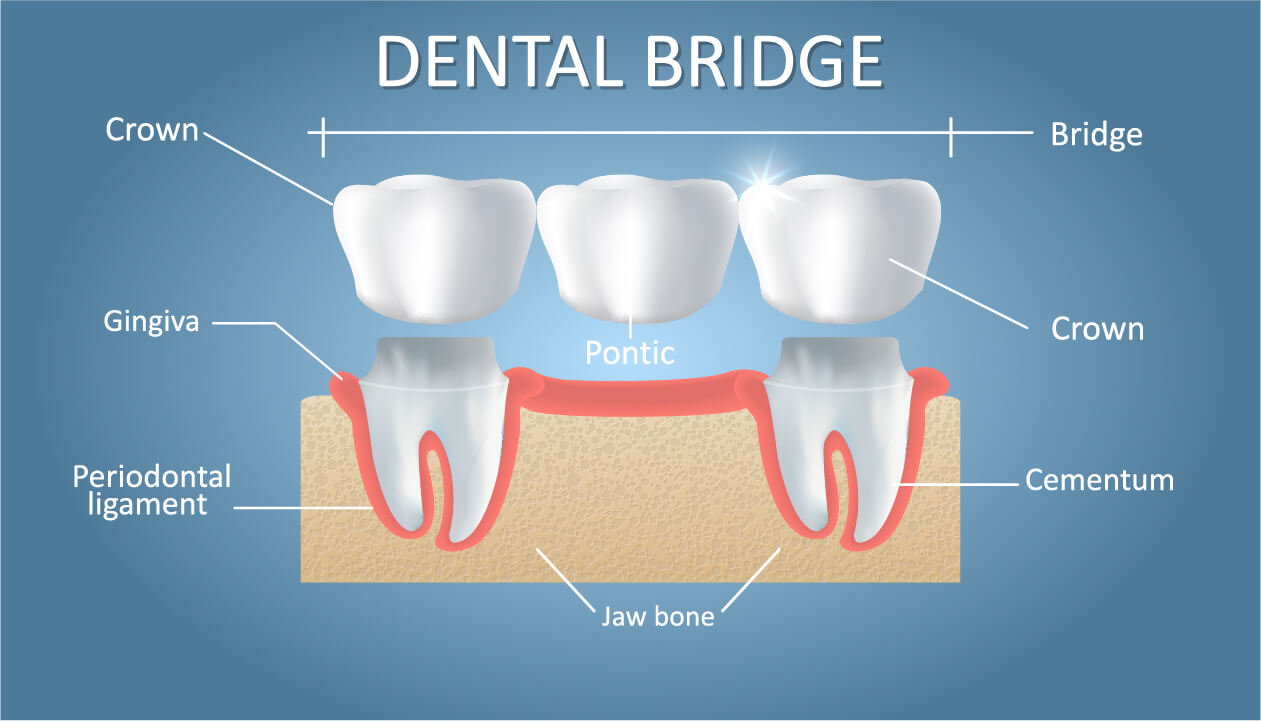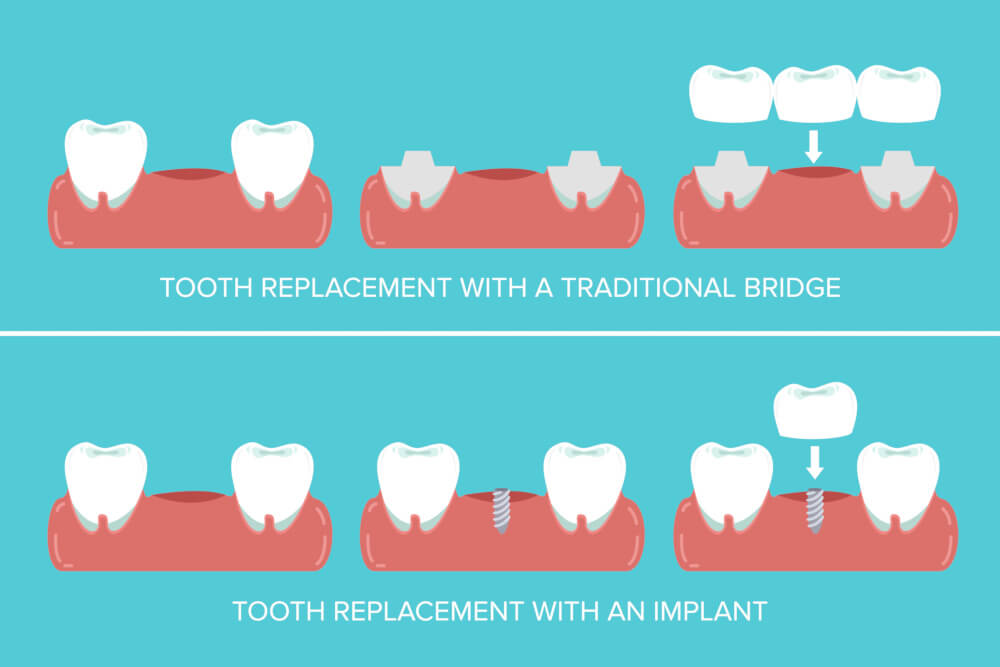
What is a Dental bridge?
A dental bridge fills in gaps caused by one or more missing teeth. The “bridge” itself is made up of a series of one or more false teeth called pontics, depending on the number of teeth that are missing within the gap. This is held in place by dental crowns on the anchoring teeth on either side of the gap, called abutment teeth. The dental bridge is a non-removable solution that helps to restore the look and function of the missing teeth, allowing the patient to chew and speak naturally.
What to Expect for my Dental Bridge Procedure?
Our Orchid Dental clinic is dedicated to being the local family dentist you can trust and count on. When you come to us with missing or irreparably damaged teeth, you can expect a thorough consultation with full disclosure of all your options.
If it is determined that the dental bridge procedure is the best route for you, two separate appointments will be made to complete the procedure. If you are replacing teeth that have been irreparably damaged, you will also require an additional appointment for tooth extraction prior to beginning the dental bridge procedure.
During the first appointment for the procedure, the abutment teeth (the two teeth on either side of the gap) will need to be prepared. This involves reshaping these teeth by removing some of the enamel and dentin so that the dental crowns can fit over them. A mold and/or scan of your teeth will also be taken in order to fabricate your custom bridge. Your dentist will also fit you with a temporary bridge to protect the newly shaped abutment teeth and hold the gap while you wait for your second appointment.
Your permanent bridge will be placed during the second appointment. Your dentist will check carefully to ensure a good fit before cementing the bridge into place.

Dental Bridge vs Implant or Denture
The three primary solutions for missing teeth include dental bridges, dental implants, and dentures. The pros and cons of each are outlined below:
The main advantage of a dental bridge is that it provides a non-removable solution that doesn’t require invasive oral surgery. The cost is also considerably less than that of dental implants and is likely to be covered by most dental insurance plans.
They are, however, less durable than implants and may need to be replaced every 5-7 years, though they can last up to 10 years. After time, they begin to lose their natural appearance and are known to cause damage to the surrounding teeth with a higher likelihood of tooth decay than for implants.
Dental implants are the most permanent solution available for missing teeth, usually lasting around 15 years or more, and even a lifetime. They have a 97% 10-year success rate and are the closest thing in appearance and function to healthy natural teeth, even preventing loss of jawbone to maintain facial shape and structure.
They do, however, come with a considerably higher upfront price tag than the other two options and involves invasive oral surgery procedures that can span over 6 months. There is also a small risk of surgical complications, and the procedure is less likely to be covered by insurance.
Dentures are the most affordable solution to missing teeth. Full or complete dentures are available for loss of the entire set of upper or lower teeth while partial dentures are used for one or several missing teeth. Partial dentures are often used as an alternative to bridges if the teeth surrounding the gap aren’t strong or healthy enough to anchor a bridge.
Their primary disadvantage is comfort level, and since they’re removable, they need to be cleaned separately from your natural teeth. They are also not as natural in appearance or function as the other options.
Contact our dental office today for a consultation if you believe you are a candidate for dental implants
FAQs About Dental Bridges
Who is a candidate for dental bridges?
Patients who have one or more missing teeth or irreparably damaged teeth that require extraction may be candidates for a bridge. The bridge will not only restore the look and function of the missing teeth, but also help maintain face shape and prevent the remaining teeth from shifting to change your bite. If the teeth on either side of the gap are not strong enough to support a bridge, a different solution is recommended.
Are there different types of dental bridges?
What we have discussed so far is a traditional dental bridge, which is by far the most popular and widely use type of bridge. There are, however, several other types of dental bridges as outlined below:
Cantilever
In a cantilever bridge, the bridge is supported by a single dental crown on a single abutment tooth on one side rather than two on either side of the gap. This solution may be used if a patient only has one healthy tooth next to the missing teeth.
Maryland
The Maryland bridge requires two abutment teeth on either side of the gap just like the traditional bridge. However, a metal or porcelain framework is cemented to the backs of the abutment teeth rather than capping them with a dental crown.
Implant Supported
This type of bridge is supported by dental implants rather than abutment teeth. It requires dental implant surgery followed by recovery time before placing the bridge. The availability of sufficient bone is key to making this procedure possible.
How do I care for my dental bridge?
Keeping your supporting teeth and jawbone healthy is key to the longevity of your bridge. Brushing, flossing, and rinsing with an antiseptic mouth wash are important daily oral hygiene practices that will aid in keeping your teeth healthy and strong. Ask your dentist to also provide specific instructions on how to best clean and floss around your new bridge. Don’t forget to see your dentist for regular checkups and teeth cleaning, and avoid hard, sticky, and sugary foods as these may cause problems for your abutment teeth or the bridge itself.
contact us now!
Are you looking to get dental bridge in Aurora CO? Contact our dental office for a consultation today!


